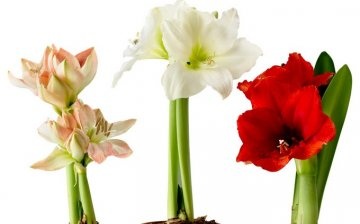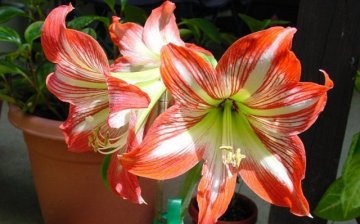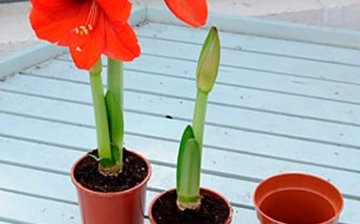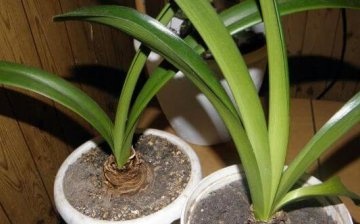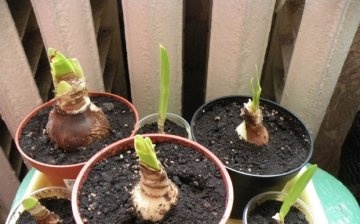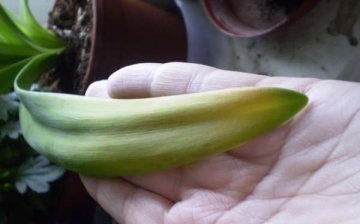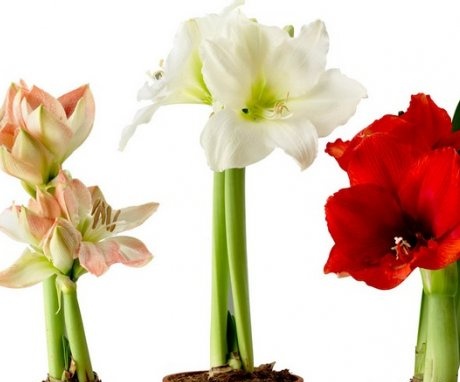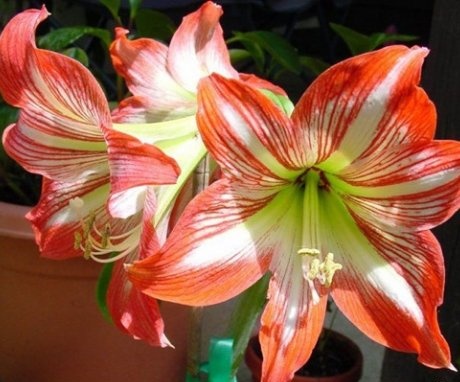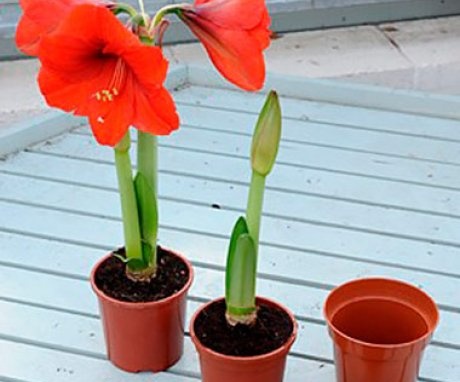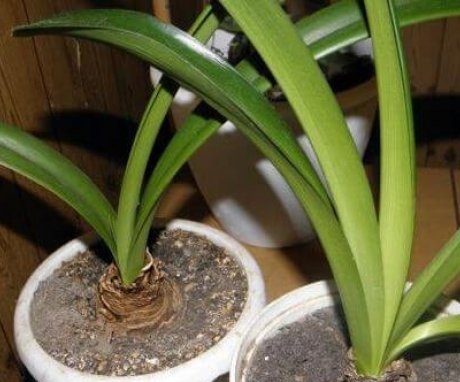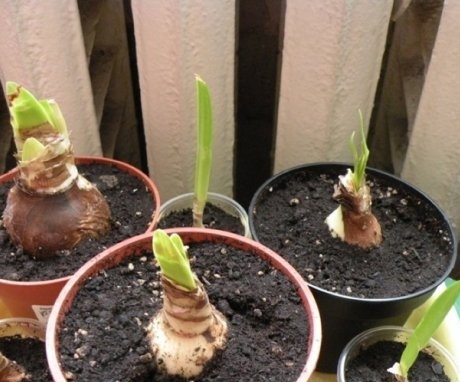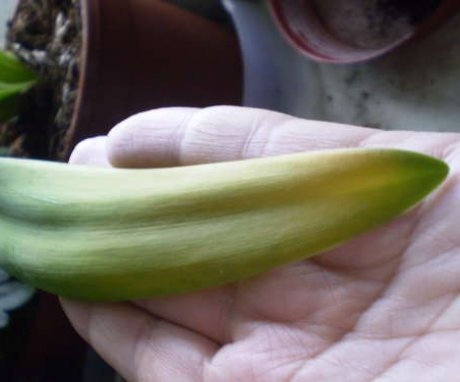Hippeastrum: home care during and after flowering
Hippeastrum - a houseplant, distinguished by an interesting large flower, similar to a tubular lily. It is a bulbous flower, while blooming no more than 1-2 times a year, and then under good conditions.
But in order for the pet to develop normally, bloom elegantly and grow in volume, it is recommended to arrange full periods of rest, as well as to take appropriate care of the indoor plant. Therefore, you should understand the intricacies of growing this shrub.
Content:
- Features of the structure of an indoor flower
- How to care for a plant during flowering
- Everything you need to know about a transplant
- The resting period in the hippeastrum
- How to care for it after flowering?
- The consequences of improper care
Features of the structure of an indoor flower
Hippeastrum comes from the Amaryllis family. In living nature, the number of various plant species exceeds more than 90 types. The exotic name of the pet from the ancient Greek language is translated as "rider" and "star".
The flower is often identified with amaryllis. But the whole difference between the representatives of the family is that the beautiful amaryllis is primarily the only specimen in its genus, and also its homeland is the southern side of Africa. While the hippeastrum has a large number of different species, as well as its location is recorded in the tropical and subtropical forests of America.
The following features of exotic are distinguished:
- The most beautiful exotic flowers are located on a high massive arrow. Because of its bright shade and durability, the plant is called royal.
- Hippeastrum is a bulbous plant, therefore it can live for more than a dozen years.
- The foliage of a green pet begins to grow only at the moment when the arrow is extended and the inflorescences bloom.
- The external structure of the plant is such that they look like a tongue, have an original rich dark green color. The upper side of the plant is glossy, but quite dense in structure.
- The sheet plate can be extended up to 50 cm in length.
- The inflorescences of the hippeastrum are large, large, reaching 25 cm in diameter. Outwardly, they are distinguished by the shape of a funnel.
- When blooming, they do not emit aroma into the air.
- If the exotic has grown, then from one large bulb, 2 powerful arrows are obtained, 3-4 flowers each.
Flowers can range in color from red and pink to white. Some species have interesting color schemes - one flower is bright red, the other is more calm pink. Other inflorescences have a striped tone. Flowering in most cases is observed either in the spring or in the spring.
How to care for a plant during flowering
The beginning of the formation of buds occurs in early February. The flowering period lasts until mid-March or even until the last numbers. But if the plant is kept in comfortable conditions, its inflorescences can withstand the period until the end of May.
The flowering period is recommended to be counted annually.3 months before the expected date, the flower is transferred from the room in which it was dormant to warmer conditions. For exotics during the growing season, a large amount of sunlight is required, so it should be placed on the southeastern or southwestern window sills.
Watering should be done as needed.
If the room is dry enough, then irrigation should be carried out frequently; if it is cool, then excessive watering is contraindicated. It is important to bring in nutritious moisture at the moment when the arrow of the flower develops and the leaf plates are stretched.
In order for the inflorescence to actively and elegantly bloom, before planting in a new flowerpot, the tuber should be kept for 3 hours in hot water at a temperature of 40 C. Thus, you should not make any special efforts before flowering. Be sure to enter a permanent watering and provide the plant with favorable conditions for normal growth and development.
Everything you need to know about a transplant
Young hippeastrum requires annual planting. The event is carried out either before the beginning of flowering, in February-March, or after the flower has completely bloomed, and prepare to move away to a dormant period. This moment comes at the end of November. For plants over 5 years of age, this procedure can be carried out once every 2 years.
How to transplant a flower correctly:
- It is recommended to start the transplant with the preparation of the container. To do this, you should take a flowerpot that exceeds the volume of the bulb by 10 cm. If the pot is much smaller, then the plant will not be able to grow normally and release the desired arrow.
- The primer can be purchased at specialized stores. A common potting soil will work. The advantages of such a soil are that a sufficient amount of mineral additives and nutrients is introduced into the soil in advance. But before landing, you should identify soil acidity... In highly acidic soil, hippeastrum will not bloom and may even die.
- You can also prepare the soil substrate yourself. To do this, combine sod soil, broken dry peat, river sand and humus. All components are taken in equal parts.
- Self-prepared soil should be preliminarily disinfect - expose to roasting in the oven, and also spill with a weak solution of potassium permanganate. This will neutralize all pathogenic bacteria and microorganisms that populate this soil.
- A drainage is placed at the bottom of the prepared flowerpot. As which you can use sea pebbles, broken brick, expanded clay or medium-sized crushed stone. The container is filled up to the middle with potting soil. A tuber is set on top. It should be covered with earth so that the soil covers it by 2/3. The rest should look out onto the street. With this appearance, it is easier to control the condition of the flower.
After planting, the plant is watered, which should be applied in moderation so that the nutrient moisture does not stagnate in the soil. Otherwise, you can provoke a fungal disease of the tuber.
The resting period in the hippeastrum
A distinctive feature of the hippeastrum is its clear delineation of life phases. He has moments of growth, flowering and relaxation. The dormant period occurs at the moment when the plant does not release an arrow, does not prepare for flowering. The onset of the moment of retirement can be regulated, due to the fact that this moment depends on the forcing of a flower of a late or early nature.
The most optimal rest time for a bulbous plant is the first days of November until the end of January.
At this point, there is a time of internal recovery after flowering. All life processes slow down, the plant rests. This condition can last from 1 to 3 months. At this point, it is recommended to recreate the optimal conditions for a comfortable stay.Only in a favorable climate is further optimal development of the hippeastrum possible.
Exota must be placed in a warm, darkened room, in which the optimum humidity will be observed. In this case, the temperature in the room should not exceed +13 .. + 15 C. During the dormant period, the plant should also be looked after. The following rules for caring for the hippeastrum during the rest period are distinguished:
- Place in a dark place.
- Dig it up.
- Arrange the tubers neatly on a wooden box.
- Make sure that the plant does not freeze.
After keeping the plant in this state for 1-3 months, the plant should be returned to its normal state. He is transferred to a warm room in a sunny place. Within 1.5-2 weeks, a young leaf will appear. Only after the appearance of a delicate leaf plate is it recommended to resume standard grooming. It is definitely recommended to put the flowerpot in a sunny place so that the sheet plates do not stretch.
A dormant period for the shrub is necessary in order to renew its own strength, to be nourished with new useful substances from the soil. After this period, the plant is again ready to please with exuberant flowering. Thus, withstanding exotics in certain conditions, you can get a gorgeous bush with blooming dense funnels of a bright shade in the spring. The main thing is to completely recreate the optimal conditions for the rest of the bush.
How to care for it after flowering?
After the shrub has bloomed, it is recommended to perform a number of necessary actions. First of all, it is necessary to give the plant the opportunity to gain strength for further growth. After all, only appropriate care will allow in the future to re-release a powerful arrow with peduncles.
After all the buds have wilted, the arrow is cut, but not completely at the root.
Above the bulb, leave about 15 cm of the base of the arrow. Due to the left stem, the exotic draws into the tuber all the nutrients concentrated in the stem. It is required to remove the arrow only after the tuber has completely taken all the nutrients from it, and it dries out. Only after that the arrow is carefully twisted out of the base so as not to damage the main plant.
After flowering, the foliage of the plant can continue to grow. She does it slowly - 1 sheet plate per month. To prevent the plant from drying out, it must be watered moderately from time to time. In addition, before the plant retires to rest, top dressing of a liquid nature should be applied. The composition of fertilizers must contain potassium and phosphorus. For good growth, the bulb should be fertilized at least 2 times a month.
The fact that the plant is preparing for the dormant period will be evidenced by the acquisition of yellow foliage. During this period, it is very important to properly prepare the exotic for retirement:
- Yellowed leaf plates are cut off.
- The introduction of the nutrient fluid is gradually stopped. Watering is carried out once every 21 days.
- The pot with the tuber is placed in a cool place with dim light.
- To prevent the tuber from releasing young leaves, it is recommended to pull it out of the ground, placing it in a dry room, or wrap it in paper, put it in the bottom drawer of the refrigerator.
Proper care after flowering and before preparing for rest will allow the plant not only to be nourished with useful substances, but also to thoroughly prepare for the next vegetative period.
The consequences of improper care
When growing hippeastrum, every gardener strives to ensure that the plant not only produces new foliage, but also blooms gorgeous. Prolonged absence of flowering can be the result of improper care of the shrub.
There are the following reasons and their solutions, thanks to which the exotic stops blooming:
- Transfer a young plant - if reproduction is carried out with the help of tubers, then a one-year-old tuber will not give an arrow.The first release of buds is possible if the tuber is more than 7 cm and the plant is older than 2 years.
- Lack of feeding - after flowering, it is definitely recommended to feed. Prolonged lack of nutrients leads to oppression of the shrub and lack of budding.
- Depleted soil - if the shrub is not transplanted from its old place for a long time, it completely sucks out all the nutrients necessary for growth from the soil. It is recommended to replant once every 1-2 years.
- Insufficient amount of light - the plant is placed on the northern windowsills. Be sure to rearrange the pot to the south side, where there will be enough sunlight for the shrub.
- The rest regime is violated - improper fulfillment of the preparation of the exotic waste for retirement and the failure to fulfill the proper conditions during this period.
Thanks to proper care, the hippeastrum will grow stronger and expand in width. Every year he will be able to give more children and release a significantly greater number of arrows. The main thing is to properly care for the shrub, not only during the flowering period, but also until the moment of budding and after flowering.
Thus, hippeastrum is an unpretentious flower that does not require additional maintenance. The most important points in its maintenance are infrequent moderate watering and control over the condition of the plant. In addition, transplantation and feeding should be carried out to saturate the exotic with nutrients.
More information can be found in the video:




